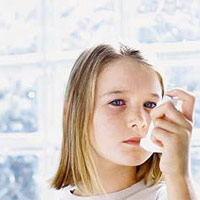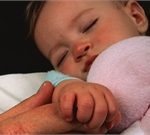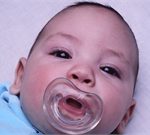Childhood Asthma
 Watching your child struggle to breathe or gasp for air can be incredibly frightening. Knowing what causes this and how to prevent and treat it will make you feel less helpless and frantic. And your assurance and calm will help your child recover more quickly and feel less frightened his/herself. Asthma is a disease caused by inflammation of the airways that can lead to difficulty breathing, coughing and/or wheezing. It often begins in childhood and affects nearly 9 million children in the US alone. Approximately 30-35% of those with childhood asthma are symptom free by the age of 21, another 30-35% have milder symptoms as they get older, and the remaining 30-35% have lifelong asthma at the same level of severity, or at a more severe level, for life.
Watching your child struggle to breathe or gasp for air can be incredibly frightening. Knowing what causes this and how to prevent and treat it will make you feel less helpless and frantic. And your assurance and calm will help your child recover more quickly and feel less frightened his/herself. Asthma is a disease caused by inflammation of the airways that can lead to difficulty breathing, coughing and/or wheezing. It often begins in childhood and affects nearly 9 million children in the US alone. Approximately 30-35% of those with childhood asthma are symptom free by the age of 21, another 30-35% have milder symptoms as they get older, and the remaining 30-35% have lifelong asthma at the same level of severity, or at a more severe level, for life.
What is happening in the body during an episode of asthma?
In a person prone to asthma, when the airways become irritated they become twitchy. As your child is breathing out the twitchy airways close too soon, trapping air in the base of the airway tubes. With the next inhalation less new air can enter because that space is already partially filled by the older air. When this happens your child might, reflexively, try to force that old air out. When forcing the air through a now narrower than normal opening a high-pitched sound can be made – a wheeze. If you have trouble visualizing this, think of how we whistle – we purse our lips so that the opening is small and then force air through to make the whistling sound. Sometimes you can hear the sound when you are near someone struggling with asthma, and sometimes even when you cannot hear the wheeze yourself, your doctor will hear it when listening with a stethoscope. Because the fresh air is not able to enter as freely as it should, your child might not be getting as much oxygen as s/he needs so s/he will begin to breathe faster to compensate. The work of breathing becomes greater as time goes on, as the airways close down sooner and sooner leaving more old air trapped and as the oxygen levels drop. The cells in the airway that produce mucus increase and older children will often cough up little pebbles of mucus, known as mucus plugs. The goal in asthma treatment (after prevention, which is always the ideal) is to stabilize the airways to prevent them from clamping down, and to pop them open when they have closed too quickly. Someone who has asthma but is not being treated properly may develop chronic inflammation of his/her airways so it is best not to ignore the symptoms of asthma, even if they are not at a severe/emergency level.
Causes/Triggers
- Genetic factors – Asthma is more common in a child whose family members have allergies, eczema or asthma. But anyone can have asthma.
- Smoke – One of the most common triggers of asthma.
- Allergies
- Increased Activity
- Viral Infections
- Cold Air/Weather Changes
- GERD (reflux) – The acid coming up from the stomach and into the throat can trigger a wheezing episode in an asthmatic person.
- Obesity
Symptoms
- Cough – usually dry/tight and often worse at night or with activity/exercise
- Wheezing – a high pitched sound when breathing out
- Chest tightness or pain – the feeling that you cannot get enough air in.
- Shortness of Breath – rapid shallow breathing.
- Difficulty breathing – working hard to breathe (signs are listed at the end of this page).
Prevention
- Keep your child in a smoke free environment.
- Breastfeeding – There have been studies showing that babies who are exclusively breastfed for 4-6 months are less likely to develop allergies and asthma. Although this is not 100% certain, there is no harm in breastfeeding exclusively during infancy if you are able.
- Healthy diet and exercise (obesity prevention)
- If your child has reflux this should be controlled via diet, environment, and medications.
- If your child’s asthma is triggered by allergies then preventing allergies is vital to minimizing their asthma. See Allergy Page for help on this front.
- If your child has frequent asthma exacerbations and it is possible for you to avoid a daycare or childcare setting you should consider home based care. This is to minimize colds when they are young and most vulnerable.
Treatment
- Allergy Prevention Medications – see Allergy Page for more details.
- GERD medications to prevent reflux.
- Oral Asthma Prevention Medications – Leukotriene Receptor Inhibitors are an example and they work by blocking some of the cells that cause inflammation in the airways. These are usually a first line of prevention for mild asthma due to the low incidence of side effects and ease of taking (once a day, at bedtime).
- Inhaled Steroids – Inhaled steroids come in many shapes and sizes. Low dose, middle range, high dose. Your child’s Pediatrician will choose the lowest dose necessary to control your child’s asthma. Steroids decrease inflammation and stabilize the airways to make them less ‘trigger happy’ when allergens/irritants/illnesses strike.
- Short Acting Beta Agonists – These are medicines like Albuterol and Xopenex – they can be used as an inhaler with a spacer or in a nebulizer (“breathing”) machine, and they work by popping open the airways that are closing during an asthma episode/attack. They work almost immediately and can be used every 4-6 hours as needed. The basic rule of thumb is that if you need to use a short acting beta agonist more than every 4 hours during an asthma episode then you need to see a doctor ASAP. If your child needs to use the short acting beta agonist more than 2-3 days per week on a regular basis then you need to look into prevention. These medications can cause your child’s heart rate to increase, can cause jitteriness, and if overused put your child at risk of severe medical complications.
- Long Acting Beta Agonists – Like the short acting agents these are used during an asthma exacerbation and often come combined with a mild inhaled steroid. They work to pop the airways open for approximately 12 hours (and the steroid component works to prevent the airways from closing up again).
- Oral Steroids – These are sometimes used for 3-5 days during an asthma exacerbation to calm the airways and decrease symptoms. Many doctors have moved toward inhaled steroids over oral steroids because inhaled steroids have fewer side effects.
When should you worry and call or see a doctor immediately?
If your child has signs of difficulty breathing:
- Fast breathing
- Shallow breathing
- Bluish discoloration around the mouth
- Grunting -A noise made in the throat with every exhalation
- Nasal flaring – The opening to the nostrils flare out with each breath
- Retractions – When your child takes a breath the skin under the ribs, between the ribs, or at the base of the neck is sucked inward with breathing.
If your child is not alert or seems unusually tired or less responsive.
If you feel that something is just not right call your physician or head into an urgent care/emergency room. Remember, no one knows your child like you do!
Note: If your child is limiting his/her activities and exercise level to prevent having asthmatic symptoms then you should call your child’s Pediatrician during regular business hours to schedule an appointment. Optimum management of asthma means that your child can live life to its fullest and participate in any/all activities.
-Monique Araya, MD, FAAP
The medical information on this Web site is provided for educational purposes only. The information provided in this site, or through linkages to other sites, is not a substitute for medical or professional care, and you should not use the information in place of a visit, call consultation or the advice of your physician or other healthcare provider.
If you believe you have a medical emergency you should call 911 or your physician immediately. If you have any questions regarding your health or a medical condition, you should promptly consult your physician.
- Accidental Poisoning
- Bites and Stings
- Burns (and sunburns)
- Childhood Asthma
- Colic and Crying Babies
- Constipation in Children
- Cough & Cold
- Diaper Rash
- Diarrhea
- Ear Pain
- Fever
- Head Trauma and Head Injuries
- Kids and Allergies
- Lice
- Medication Dosages
- Nosebleeds in Children
- Pink Eye and Styes
- Rash
- Scrapes, Cuts and Stitches
- Sudden/Acute Abdominal Pain
- Treating a Common Cold Cough
- Vomiting and Nausea
 High Viral Loads Make Kids ‘Silent Spreaders’ of COVID-19
High Viral Loads Make Kids ‘Silent Spreaders’ of COVID-19 Clotting Tied to COVID-19 May Harm the Placenta
Clotting Tied to COVID-19 May Harm the Placenta ‘Kangaroo Care’ Has Big Health Benefits For Preemies
‘Kangaroo Care’ Has Big Health Benefits For Preemies Babies Are Spared Severe COVID-19 Symptoms
Babies Are Spared Severe COVID-19 Symptoms Sleepless Babies May Face Emotional Troubles as Kids
Sleepless Babies May Face Emotional Troubles as Kids